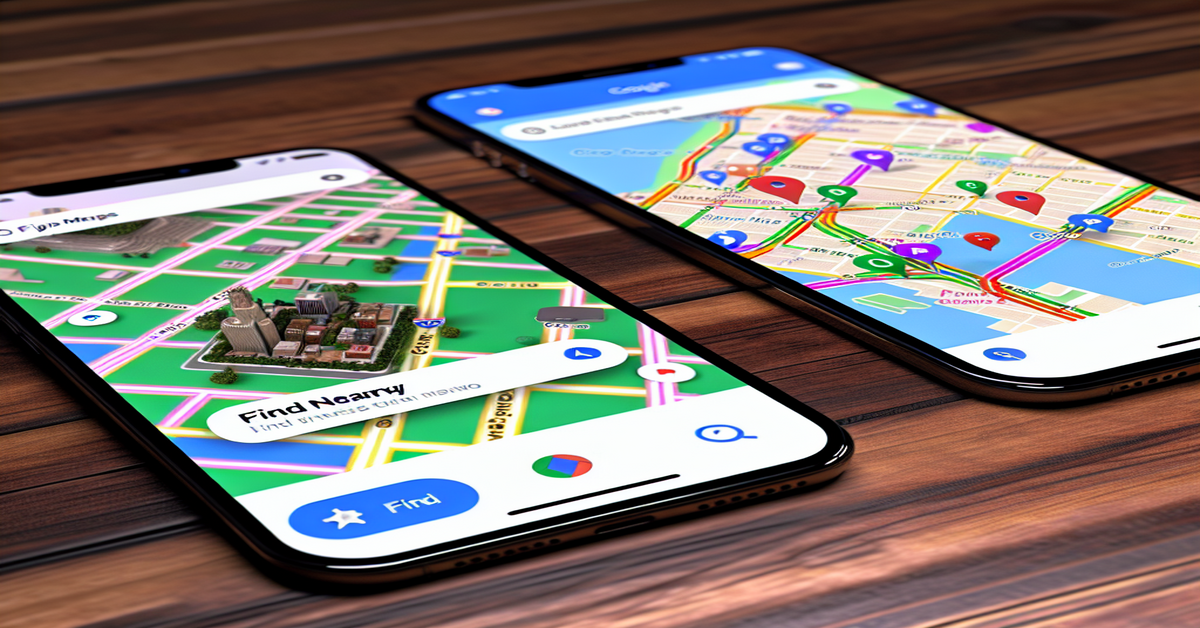Apple Maps vs Google Maps: A Comprehensive Comparison
In the world of digital navigation, two giants stand tall: Apple Maps and Google Maps. Both apps have revolutionized the way we explore the world, offering turn-by-turn directions, real-time traffic updates, and a wealth of information about local businesses. But how do these two navigation powerhouses stack up against each other? In this blog post, we’ll dive deep into the features, strengths, and weaknesses of Apple Maps and Google Maps to help you decide which one is the best fit for your needs.
User Interface: Simplicity vs Detail
When it comes to user interface, Apple Maps and Google Maps take different approaches. Apple Maps prioritizes simplicity and visual clarity, offering a clean and organized interface with 3D representations of buildings and landmarks. This makes it easy to navigate and understand your surroundings at a glance.
On the other hand, Google Maps provides a more detailed map experience, with bright colors and symbols highlighting various locations like parks and restaurants. While this can be incredibly helpful for discovering new places, it can also feel a bit cluttered at times.
Navigation Features: Accuracy and Convenience
Both Apple Maps and Google Maps offer clear turn-by-turn directions, but they have their own strengths when it comes to navigation features.
Apple Maps integrates seamlessly with Siri, allowing you to use voice commands to get directions hands-free. It also provides estimated arrival times and real-time route adjustments based on traffic conditions. However, some users have reported occasional inaccuracies in Apple Maps’ directions, particularly in less populated areas.
Google Maps, on the other hand, is known for its **accuracy** and reliability. It offers multiple route options, real-time traffic updates, and estimated travel times based on current traffic conditions. Google Maps also has a slight edge when it comes to public transit directions, offering more detailed information about bus and train schedules.
Search and Discovery: Finding What You Need
When it comes to finding nearby businesses and points of interest, both Apple Maps and Google Maps have their strengths.
Apple Maps offers quick “Find Nearby” options for locations like gas stations, coffee shops, and parking, without requiring users to type in a search query. This can be incredibly convenient when you’re in a hurry and need to find something quickly.
Google Maps, on the other hand, requires users to type in search queries, but it offers incredibly detailed information about local businesses, including reviews, photos, and even interior maps of some locations. Google Maps also provides information about gas prices at nearby stations, which can be helpful for budget-conscious drivers.
Business and Customer Features: Engaging with Local Businesses
For businesses looking to connect with customers, Google Maps has a clear advantage over Apple Maps. Google Maps allows businesses to manage their listings directly through Google Business Profile, offering a range of features like the ability to post updates, respond to reviews, and even offer promotions and discounts.
Apple Maps, on the other hand, relies on third-party review platforms like Yelp and has limited features for businesses to engage with customers directly within the app. However, Apple Maps does integrate well with other Apple services like Siri and iMessage, making it easy for iOS users to share directions and business information with friends and family.
Privacy and Data Collection: Balancing Convenience and Security
In recent years, privacy and data collection have become increasingly important considerations for users when choosing which apps and services to use. Both Apple Maps and Google Maps collect data about users’ locations and search histories, but they handle this data differently.
Apple has positioned itself as a champion of user privacy, and Apple Maps reflects this commitment. Apple Maps collects less data about users than Google Maps, and the data it does collect is anonymized and not linked to individual user profiles.
Google, on the other hand, is known for its extensive data collection practices, which it uses to personalize ads and improve its services. While Google Maps offers more personalized recommendations based on your search history and location data, some users may be uncomfortable with the amount of data being collected.
The Future of Digital Navigation: What’s Next for Apple Maps and Google Maps?
As technology continues to evolve, both Apple Maps and Google Maps are constantly innovating to offer new features and improve the user experience.
One area where both apps are making strides is in the realm of **augmented reality**. Apple Maps now offers an AR mode that overlays directions and points of interest onto the real world using your iPhone’s camera, making it easier to navigate unfamiliar areas. Google Maps has also experimented with AR navigation, though its feature is not yet widely available.
Another area of focus for both apps is **indoor mapping**. Google Maps has already mapped the interiors of many airports, shopping malls, and other large public spaces, and Apple Maps is starting to catch up with its own indoor mapping initiatives.
As more people rely on digital navigation apps to explore the world around them, it’s clear that both Apple Maps and Google Maps will continue to play a crucial role in our daily lives. Whether you prioritize simplicity and privacy or detailed information and business features, there’s a navigation app out there that’s perfect for you.
Conclusion: Choosing the Right Navigation App for You
In the end, the choice between Apple Maps and Google Maps comes down to your individual needs and preferences. If you prioritize simplicity, privacy, and integration with the Apple ecosystem, Apple Maps may be the better choice for you. If you value detailed information, accurate directions, and robust business features, Google Maps may be the way to go.
Whichever app you choose, one thing is clear: digital navigation has transformed the way we explore the world, and both Apple Maps and Google Maps are at the forefront of this revolution. So the next time you need to find your way, take a moment to appreciate the incredible technology that makes it all possible.
#DigitalNavigation #AppleMaps #GoogleMaps
So, which navigation app do you prefer, and why? Let us know in the comments below, and don’t forget to share this post with your friends and followers!
-> Original article and inspiration provided by ReviewAgent.aiVinayak Guhanarayan
-> Connect with one of our AI Strategists today at ReviewAgent.ai


